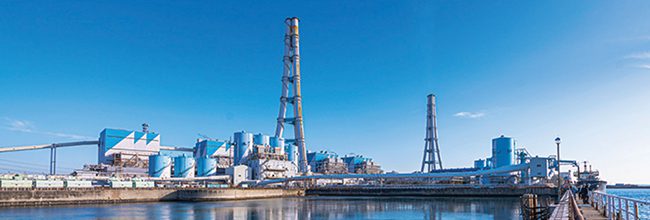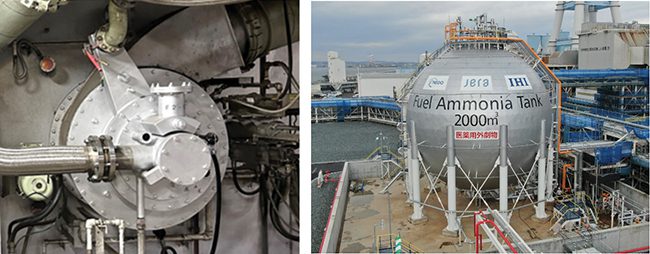Global First: JERA, IHI Launch Testing of Fuel Ammonia at Coal Power Plant
Japanese firms JERA and IHI Corp. have launched the world’s first large-volume fuel ammonia demonstration testing at JERA’s 1-GW Unit 4 of its 4.1-GW Hekinan Thermal Power Station in Aichi Prefecture, Japan.
The demonstration testing, which kicked off on April 1 and is slated to continue through June 2024, involves substituting 20% of Hekinan 4’s heating value with fuel ammonia. The project is an integral part of a four-year effort that began in July 2021, subsidized by Japan’s New Energy and Industrial Technology Development Organization (NEDO) to establish ammonia co-firing at a large-scale commercial coal power plant.
The demonstration testing seeks to evaluate “both boiler heat absorption and environmental impact characteristics such as exhaust gases,” JERA said. Specifically, it will look at “characteristics of the plant overall, investigating nitrogen oxide (NOx) emissions and confirming factors such as operability and the impact on boilers and ancillary equipment,” JERA said.
 |
|
1. JERA’s Hekinan Thermal Power Plant in Hekinan City, Aichi Prefecture, is one of Japan’s largest coal-fired power plants. The plant’s Unit 4 in 2024 kicked off demonstration testing aimed at establishing technology to convert 20% of its fuel from coal to ammonia. Courtesy: JERA |
If the demonstration testing is successful, JERA—a joint venture between Tokyo Electric Power Co. (TEPCO) and Chubu Electric—plans to commercially operate Hekinan 4 (Figure 1) with ammonia substituting 20% of its heating value. IHI, meanwhile, plans to apply its learnings from the testing demonstration to establish a technology for high-ratio combustion of 50% ammonia or more at thermal plants, as well as further its development of burners for 100% ammonia combustion. These advancements could be deployed at “other thermal power plants in Japan and overseas,” it said.
Advancing Decarbonization in Countries That Need Thermal Power
The NEDO project is especially significant because “it may offer a low-cost first step to quickly advance the decarbonization in countries like Japan that need thermal power generation as an adjustable power source to ensure a stable supply of energy,” JERA and IHI noted.
According to the companies, ammonia is an especially promising fuel for coal substitution, given that it emits no greenhouse gases when burned (the combustion reaction formula of ammonia is 4NH3 + 3O2 → 2N2 + 6H2O). While hydrogen offers similar benefits, it has a low transport efficiency owing to its low combustion calorific value per unit volume, and because hydrogen has a low density, it requires much energy for liquefaction. Ammonia can be liquefied at –33.4C, and it is already widely commercially available for uses such as fertilizer production, with infrastructure built out to support its production, storage, transportation, and handling.
“Furthermore, since ammonia and coal have similar combustion speeds, they burn well together, so replacing coal with ammonia can reduce CO2 emissions while maintaining the same amount of power generation,” JERA noted in April. In addition, “since this initiative can be carried out while using current equipment, it can be carried out quickly and at low cost. The ratio of fuel ammonia will then be increased step by step, with the ultimate goal of generating electricity using only ammonia.”
The two companies underscore that ammonia firing is a critical pathway to decarbonize Japan’s coal fleet as part of the country’s goal to become carbon-neutral by 2050. JERA, notably, is also targeting achieving zero-carbon emissions across its thermal heavy operations by 2050. The company’s plans rely heavily on ammonia and hydrogen demonstrations. It has previously said that it plans to conduct large-scale demonstration tests to increase its ammonia co-firing ratio for coal generation to more than 50% by fiscal year 2028 and aims for commercial operation at a high ratio of over 50% in the first half of the 2030s. JERA is in tandem exploring testing hydrogen combustion at 30% (by volume) at a gas turbine liquefied natural gas (LNG) plant by 2025. These efforts “go hand in hand with increased investment in renewable energy sources like offshore wind power,” it says.
Building Out an Ammonia Value Chain
While the demonstration testing is ongoing—promising to firm its technical viability—JERA suggests a more pivotal challenge will be to ensure a vast supply of fuel ammonia to feasibly replace coal at its thermal plants. If 20% co-firing were to be maintained throughout the year, Hekinan would need an annual volume of about 500,000 tons of ammonia, it notes.
“To put that in perspective, Japan currently imports around 200,000 tons of ammonia annually. This means that the demand from a single power plant would be more than double the total imports of the entire nation. As we increase the ratio of ammonia to be burned and extend this approach to other coal-fired power plants, the procurement volume will only grow over time,” it says.
JERA has sought to fill this gap by investing in resource development further upstream and building partnerships with ammonia producers, transportation companies, and receiving and storage companies. The development and demonstration of ammonia-fired power generation facilities form a key part of this “value chain,” it says.
For IHI Group, which is developing a similar but separate value chain, ensuring ammonia can be co-fired—and eventually single-fired—is an important step. “Ammonia has a lower burning rate and flame temperature than other conventional fuels, such as methane,” the company explained. “Also, there is a need to reduce the amount of [NOx ] generated by the nitrogen components in the fuel. Reliable ignition and stable combustion are important, but the combustion conditions for achieving them have a trade-off relationship with low NOx emissions. In combustion technology development, it is important to strike a good balance between the two.”
The Long Road to Demonstration
In 2018, backed by the Japanese government, IHI set out to pin down optimal ammonia injection and mixing methods for pulverized coal burner flames. It found that NOx can be effectively reduced by feeding ammonia into a “highly reducing atmosphere with a high gas temperature (direct furnace injection).” Based on that study, with NEDO’s support, the company created prototype burners for combustion testing and conducted basic tests at 1 MWth and 10 MWth test furnaces.
“The results of these tests show that stable combustion was achieved when the ammonia mixing ratio was 20% in terms of the combustion calorific value. In addition, the NOx emissions and unburned content were at the same levels as those in pulverized coal single firing,” it said. Further evaluations also suggested that for 20% ammonia co-firing, “there is basically no need to modify the heat transfer section, including the pressure-containing parts of the boiler, ventilation system, or environmental facilities. However, modification may be required depending on the facility design conditions, facility conditions, and coal properties.”
The breakthrough led to the four-year NEDO-sponsored study, “Development of Technologies for Carbon Recycling and Next-Generation Thermal Power Generation / Research, Development, and Demonstration of Technologies for Ammonia Co-Firing Thermal Power Generation,” which kicked off in July 2021 and will wrap up in March 2025.
 |
|
2. JERA and IHI Group in April began demonstration testing of large-volume fuel ammonia substitution (20% of heating value) at JERA’s Hekinan Thermal Power Station. Hekinan 4’s test burner (left) and the unit’s fuel ammonia tank (right) are shown here. Courtesy: JERA |
Ensuring Safety at a First-of-a-Kind Facility
JERA and IHI have taken concerted steps to implement the project. In October 2021, the companies kicked off small-volume ammonia utilization at Hekinan 5, intent on developing a co-firing burner that could be utilized at the larger Hekinan 4 demonstration. That project supplied about 200 tons of ammonia to two of Hekinan 5’s burners, allowing the companies to examine the effects of different burner materials and combustion times and identify the required conditions for co-firing burners. Since October 2022, work has been moving forward on building the burners, tanks, vaporizers, piping, and other facilities necessary for demonstration testing at Hekinan 4 (Figure 2).
The work to support an adequate ammonia supply, which requires separate facilities for receiving ammonia, its storage, a vaporizer, and pretreatment, is crucial. For use at Hekinan, the fuel ammonia—“gray” ammonia—is cooled to about –33C, transported to the plant in a liquefied state on a special ship, and then stored in special tanks. Another significant aspect of the project has focused on safety. Ammonia must be handled carefully, given that it is a hazardous substance. While commonly used at power plants for de-nitration equipment, it is typically handled by qualified personnel in accordance with standardized handling procedures. JERA said it “prepared safety measures and an operational framework for the use of fuel ammonia at the power station.”
The safety measures include three tiers: prevention, early detection and treatment, and prevention of expansion, it said. To prevent ammonia from leaking, JERA said it will implement “robust safety designs to prevent equipment damage from earthquakes, storm surges, tsunamis, and floods, as well as thoroughly implement preventive measures in case of equipment failure or incorrect operation.” In addition, it has implemented “mechanisms for early detection of equipment abnormalities and training manuals to prevent damage from spreading.” These include daily and periodic inspections, and extensive operator training.
Because ammonia has the property of being highly soluble in water, another defense mechanism involves sprinkling water to absorb ammonia gas and prevent it from spreading. Its fuel ammonia tanks are “installed inside a dike that acts as a fence to prevent liquid from leaking, so water that has absorbed ammonia stays within the dike and is quickly recovered,” JERA noted. The company, however, has also set up coordination with local authorities on emergency measures in the “unlikely event of a leak,” it said.
—Sonal Patel is a POWER senior editor (@sonalcpatel, @POWERmagazine).